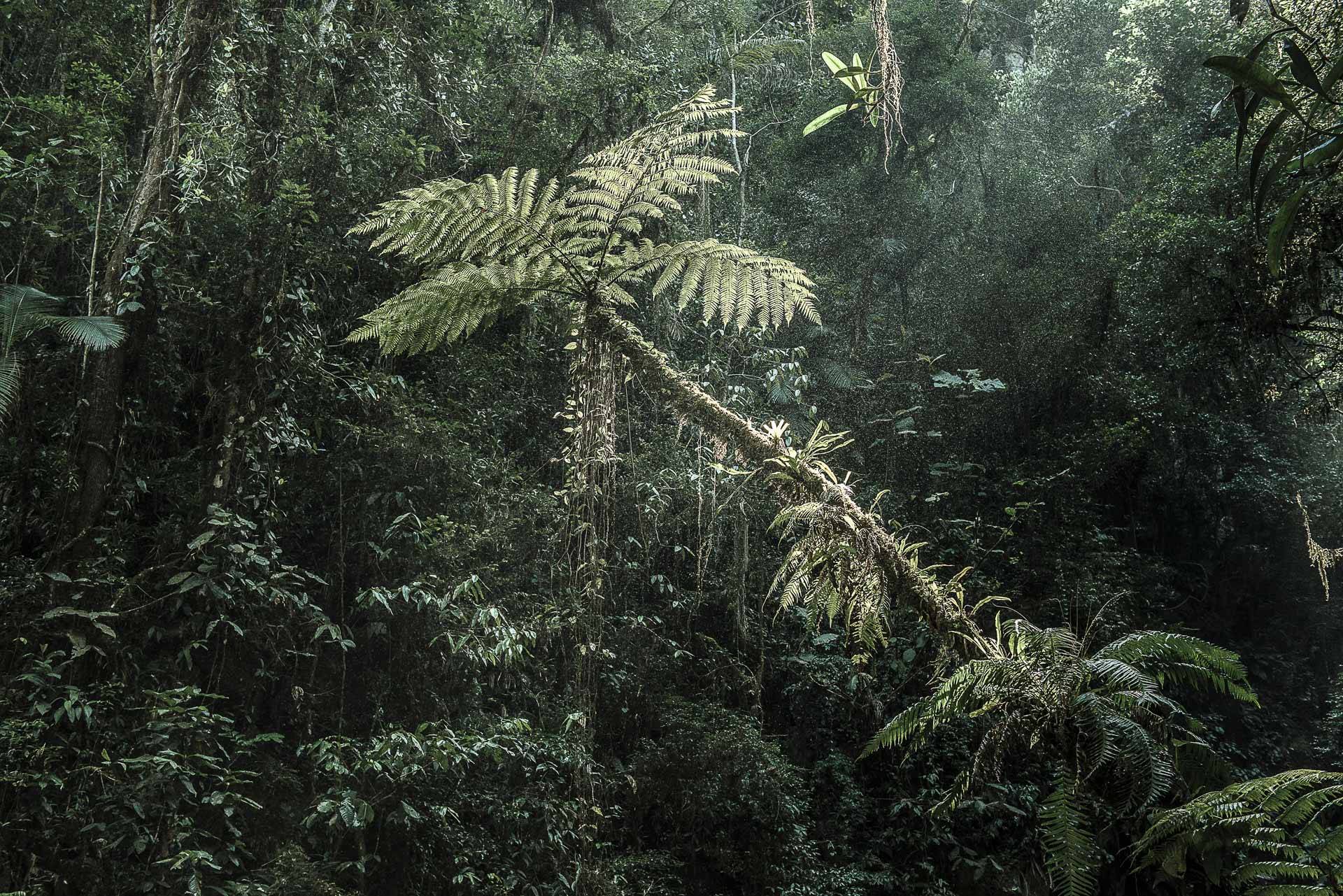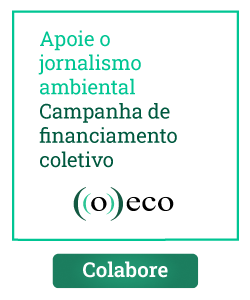Over the past five centuries, the Atlantic Forest has been exploited, occupied and gradually exterminated. A biome that once stretched along almost the entire coastline of Brazil has given way to cities where 70% of the country’s population today lives. What remains of the forest is just a fraction of what it used to be. More recent history has been less cruel to the Atlantic Forest, thanks to multiple efforts aimed not only at protecting what’s left, but also at recovering what was lost. The path toward restoration goes beyond bringing back tree cover, and includes the return of native fauna.
A recent satellite imagery survey by the collaborative mapping platform MapBiomas shows that, in 2020, the remaining Atlantic Forest cover was 25.8% of its original area. In the past 36 years, the biome has lost 1.3% of its original forest cover, revealing that, while deforestation here has slowed down, it’s still advancing. According to MapBiomas, 10 million hectares (25 million acres) of primary vegetation were lost between 1985 and 2020.
On the other hand, there are areas where the forest has regained its space. Secondary forest cover, in the early stages of regeneration, grew by approximately 9 million hectares (22 million acres) in the same period.
The near-identical figures for deforestation and vegetation recovery don’t indicate that an ecological balance has been achieved, given that old-growth forests have an irreplaceable environmental value. Even so, conservationists say the restoration initiatives mean hope for better days for the Atlantic Forest.
Restoring natural areas is considered a key action to combat and mitigate the effects of climate change, and a core strategy to guarantee water and food security, in addition to other ecosystem services and protection of biodiversity itself. To that effect, the United Nations has declared 2021-2030 the “Decade on Restoration.”
In its 2015 commitment to the Paris Agreement, Brazil became the first country to pledge the restoration of 12 million hectares (30 million acres) of natural areas by 2030 “for multiple uses,” among the other targets of its nationally determined contribution (NDC). The commitment extends to all Brazilian biomes.
Other commitments overlap this one, such as the Bonn Challenge, with its global scope, where Brazil has committed to restore 22 million hectares (54 million acres) of forests by 2030, and the 20×20 Initiative, which brings together Latin American and Caribbean countries with the target of also restoring 22 million hectares.
For restoration efforts to meet the targets, monitoring, calculating and systematizing the information is necessary, experts say. The information must be available in a standardized, transparent and accessible way that shows where and how much is being restored, and by whom. This is one of the main bottlenecks that Brazil needs to overcome toward its 2030 goals, experts say.

Over the course of four months, we tried to locate native forest restoration efforts to measure how much progress is being made on the goals. After submitting 28 requests based on the freedom of information law to state and federal environmental agencies, scouring research databases, and speaking with researchers and organizations in the sector, it became clear that neither state nor federal authorities have a standard for producing that information. The data either don’t exist, or are decentralized.
This points to environmental and open data policies that lack national guidelines to generate indicators, according to several reports by the Achados e Pedidos project, a collaboration by Transparência Brasil, Abraji and Fiquem Sabendo. The project has been monitoring environmental transparency since 2020, with support from the Ford Foundation. Its most recent report shows that almost half of the data needed to monitor the environmental policies of Brazil’s Ministry of the Environment (MMA) are unavailable or incomplete.
The Restoration and Reforestation Observatory is an initiative of the Brazilian Coalition on Forests, Climate and Agriculture, a movement with more than 300 members from the private sector, the financial sector, academic institutions, and civil society. Launched in May 2021 to pursue this information, the observatory has also run up against the same the problem of the data being decentralized and unavailable. The observatory’s indicators depend on collaboration with the agencies responsible for restoration projects, who need to fill in a form and provide geographic data. Some states, such as São Paulo and Espírito Santo, have shared geolocation information with researchers through cooperation agreements. These were the most complete and organized structured data sets we could find.
At present, restoration activities in Brazil cover 79,130 hectares (195,534 acres), of which more than 90%, or about 76,000 hectares (187,800 acres), are located in the Atlantic Forest. These comprise 651 project areas in municipalities with at least 80% of their territory located in the Atlantic Forest, which means the total may contain small parts of forests recovered in other biomes.
The observatory also analyzes two other categories: reforestation, mostly with exotic species, which can be commercially exploited or not; and regeneration, which are areas in transition from human use, such as pastures and plantations, to natural cover. These are lands that have been deforested and exploited for some human activity but ended up being abandoned and, thanks to time and nature, are gradually recovering their vegetation, which is considered secondary at this stage.
“You have restoration projects run by NGOs, companies, collectives, and there is the outline of the area, saying that there is a restoration project underway there, because it’s a long-term process,” says Mariana Oliveira, project manager at World Resources Institute (WRI) Brazil, one of the member organizations of the Brazilian Coalition, which participated in developing the observatory. “We have data from MapBiomas, which tracks land use transitions. And the specific databases on plantations for economic purposes, which have to be done because they often need authorization from enforcement agencies to cut and manage forests.”
Given this scenario, she says, “the observatory will try to provide a first glimpse and find where the bottlenecks are. The observatory is not perfect, we know that there is a lot of underestimated data, or lots of data that need further development, we know that there is lack of organization. But it’s a first step, and we’ll build it from there. And those numbers are all backed up by reliable organizations,” Oliveira adds.
Marcos Rosa, technical coordinator of MapBiomas, says that to obtain a more reliable overview of the recomposition of native forest and reduce misinterpretation in young forests, secondary vegetation areas are only entered into the MapBiomas platform if they have been around for three years. Unlike the observatory, MapBiomas’s methodology for secondary vegetation doesn’t distinguish between regeneration and restoration (which is a limitation of the image-based tracking it uses), but it does rule out forestry activities. However, in the early stages of cultivation, these areas may cause distortions in the interpretation of satellite data.
To better understand this dynamic, fieldwork is essential to know what is being done in each area. But specific restoration projects in states are rare, and the private sector is not always held accountable, according to Rosa: “A large part of restoration is carried out by private landowners, and not all of them want to share that information. And states haven’t even validated the recovery plans registered on the CAR [Rural Environmental Register] so far.” Even in the case of compensation measures that landowners have agreed to in lieu of penalties, known as conduct adjustment agreements (TAC), the information remains limited, Rosa says, as compliance with the agreements is not enforced.
“It’s common for some areas to shrink over time, since much of what is regenerated is cut down again; that’s what we call ephemeral forest, because it doesn’t consolidate,” he says.
In the Atlantic Forest, according to Rosa, this ephemeral quality has an extra reason: under Brazil’s Atlantic Forest Law, recovered areas that are more than 10 years old become protected and may not be deforested again. “Rural producers sometimes leave land abandoned for five or six years, and when a forest starts to form there, they clear it again, even if they are not going to use the area for any economic purposes, just to avoid falling into permanent protection status,” Rosa says.
Along with the 76,000 hectares under restoration there, the Atlantic Forest also hosts 794,460 hectares (1.96 million acres) under natural regeneration and another 5.37 million hectares (13.3 million acres) located in reforestation areas (mostly exotic species, including for commercial exploitation), according to the Restoration and Reforestation Observatory.
“What guarantees that the forest will remain is connection,” says WRI’s Oliveira. “It may come through a project — an NGO goes there and establishes a project with a rural producer who signs a document and will take care of that area for 10, 15 years. Or it may be a legal request, when rural producers make a PRADA” — Project for Recomposition of Degraded and Altered Areas — “then they are linking it to their [property registration] numbers, which are related to the Forest Code, pledging to keep that area. This is very important. There has to be some kind of connection for that forest to stand.”

The role of the Forest Code
The 12 million hectares to be restored under Brazil’s NDC to the Paris Agreement — almost three times the size of the state of Rio de Janeiro — isn’t some arbitrary number. The figure is an estimate of the country’s native vegetation deficit: areas that, by law — the Forest Code — must have vegetation cover. These include permanent preservation areas (APPs), riverbanks, springs, slopes, and legal reserves, the portion of a rural property that landowners must preserve.
In other words, “enforcing the law is not enough” to meet the country’s target under the Paris Agreement, Oliveira says.
Specifically in the Atlantic Forest, a recent analysis published in Sustentabilidade em Debate points to a 4.74-million-hectare (11.71-million-acre) deficit of native vegetation, comprising 2.76 million hectares (6.82 million acres) in permanent preservation areas and 1.98 million hectares (4.89 million acres) in legal reserves.
Another example of this regulatory bottleneck came to light in a report published in August 2021, which revealed that only nine of Brazil’s 27 states updated their state laws on forest replacement in cases of authorized deforestation. According to the 2012 Forest Code, that update is mandatory.
Thirteen states updated their legislation only partially; four didn’t do so at all; and one, Sergipe, doesn’t even have any state legal framework on the issue.
Government databases fail to give detailed information
Responses to questions filed under the freedom of information law to federal and state agencies working on environmental policy confirmed what experts have already observed in their restoration monitoring studies: there are no centralized data; almost nothing is systematized; and there is no central governance to coordinate actions in the public sphere.
In the federal government, we questioned the Brazilian environmental protection agency, IBAMA, which is linked to the Ministry of the Environment, and the Brazilian Forest Service (SFB), which has operated under the Ministry of Agriculture, Livestock and Food Supply (MAPA) since the start of President Jair Bolsonaro’s administration in 2019.
IBAMA pointed us to its Simplified Register of Vectors (CASV) for forest recovery data. According to the agency, it “is a significant evolution in the management of these areas, since it produces publicly available data with proper geospatial basis, enabling users to automatically generate panels that consolidate the information entered into the system.” However, the system still doesn’t allow for detailed screening and individual assessment of the recovery status of each area.
The CASV currently identifies 1,415 areas under recovery throughout the country, totaling 157,600 hectares (389,400 acres). There’s no way to filter by biome or differentiate between restoration/regeneration and reforestation/forestry, but it is possible to quantify by state: in the 17 states of the Atlantic Forest, there are 1,077 areas, totaling 52,700 hectares (130,200 acres) under recovery.
The Brazilian Forest Service recommended databases not administered by the government, such as those run by MapBiomas and the observatory itself. “Regarding projects to recover existing forest areas in Brazil, the state environmental agencies would be the recommended source for obtaining such data,” the SFB’s General Coordination for Forestry Promotion and Inclusion said. In the same reply, the SFB’s General Coordination for Forestry Inventory and Information said “there is no consolidated information on recovered forest areas on the National Forest Information System [SNIF].”
The governance bottleneck
At the federal level, the two main instruments guiding the issue of environmental restoration should be the National Plan for Recovery of Native Vegetation, known as Planaveg, and the National Policy for Recovery of Native Vegetation, Proveg. Both were launched in 2017. Their coordination, in turn, would be the responsibility of the National Commission for Recovery of Native Vegetation, or Conaveg.
In April 2019, however, the Bolsonaro administration scrapped Conaveg as part of a “wave of revocation” of government commissions. In December of that year, the government reconsidered its decision and revived Conaveg, but with a new makeup: seven members, all from the executive, without the participation of civil society (which previously had two representatives).
“During Planaveg meetings, back there, we found out that governance was one of the bottlenecks,” says WRI’s Oliveira. “How do you manage a plan that will include data on municipalities, states, institutions, etc.? And there, at its first meeting, Conaveg stated that this was one of the points to be addressed, because it was already posed as a challenge in itself, even with government support.
“When this changes, and [the commission] is undermined and disorganized, and civil society is removed from that environment, we lose information on how it is being discussed,” she adds. “At an event in which we participated with the ministry, it was clear that nothing had moved forward in terms of definitions. Some people who are super competent and are working to make Planaveg happen have advanced on other fronts, but it has not been done in terms of coordination and a robust structure for building platforms, for political coordination.
In contrast to the federal government, which lost its function by undermining Conaveg, state governments and civil society have been working hard to fill the leadership void in the restoration agenda.
One such example is the Pact for Restoration of the Atlantic Forest, a multisectoral movement created in 2009 and which has set its own restoration targets. The first target, of 1 million hectares (2.5 million acres), was accomplished in 2020. The next target is much more ambitious: to restore 15 million hectares (37 million acres) of Atlantic Forest by 2050.
The national coordinator of the Pact for Restoration, Ludmila Pugliese, says the target was set after mapping potential areas for restoration in the Atlantic Forest. Unlike Brazil’s NDC, it includes more than just permanent preservation areas and legal reserves.
“We are suggesting that this should even be an economic strategy beyond the limits of APPs and legal reserve areas,” Pugliese says. “We want restoration to take place in areas that are not very suitable for agriculture, for example, but are suitable for forests. We also work with the possibility of restoration being productive, with species that can be used for commercial purposes and agroforestry systems. We seek alternatives that are viable within the arable and productive areas of the property because we see it as a path, and also as a development agenda, not just an environmental one.”
States have also made their own commitments. Espírito Santo, for instance, joined the 20×20 Initiative with the target of restoring 80,000 hectares (197,700 acres) by 2030, a quarter of it through planting and the rest through natural regeneration. São Paulo state has set a target of restoring 1.5 million hectares (3.7 million acres) by 2050 through its Refloresta SP Program, more than half of it under its Environmental Regularization Program (PRA).
The response of states
The Atlantic Forest is spread across 17 Brazilian states, running from the country’s south to its northeastern coast. In three of the states — Rio de Janeiro, Espírito Santo and Santa Catarina — the Atlantic Forest is the only biome that occurs there. In the others, it shares space with the Cerrado savanna, the Caatinga scrub forest, or the Pampa plains.
When questioned, most states pointed to environmental licensing systems or the CAR registry of rural properties as the available repository for forest restoration data. But neither database provides information that allows users to distinguish between restoration, regeneration and reforestation. Each process needs to be observed to identify the forest recovery strategies implemented.
Another common response by states was that data on restoration processes are kept only in physical files. In other cases, the denial was more simplistic. The Bahia state environmental department, for example, only said that “this is a broad request, related to information that is being systematized. Therefore, it is impossible to meet the request adequately on this occasion.” The Rio Grande do Norte environmental and water resources department reported that it “does not have the information requested.
Espírito Santo at the forefront of restoration
In terms of state policies aimed at promoting restoration, Espírito Santo stands out with its Reflorestar program, launched in 2011. In response to questions, the state environmental and water resources department, or Seama, presented a detailed list including 3,700 areas with standing forests or recovery projects recognized in the state, which is located entirely in the Atlantic Forest biome. The areas under recovery in 2015-2019, according to the list, total 900 hectares (2,224 acres). In the Restoration and Reforestation Observatory’s survey, Espírito Santo stands out as the state with the highest proportion of restoration mapped for Atlantic Forest areas in its territory (1.79%).
“Reflorestar is a program that supports planting forests,” says program manager Marcos Sossai. “It is not a PES-based [payment for ecosystem services] program. PES is the main strategy, but it’s not the only one. Through PES, we are able to transfer financial resources to rural producers so they can plant forests.”
Sossai says that in addition to native forest itself, the program also supports forest arrangements that combine income generation with conservation, such as agroforestry systems with cocoa, coffee, peach palm, and banana cultivation; and forest management without clear-cutting, including conversion of pastures into silvopastoral systems, which integrate grazing land with tree cover. “This is important because sometimes it helps to connect fragments. And 40% of our state is pasture, so not thinking of improving pasture as a solution is wrong,” Sossai says.
In all, the program accepts six types of land use, each with specific requirements. In addition to planting native plants, agroforestry, silvopasture, and managed forest without clear-cutting (which excludes exotic species such as eucalyptus), Reflorestar also promotes natural regeneration (isolating and eliminating degrading factors for the biome’s natural recovery) and standing forest, which corresponds to native cover in the early stages of regeneration.
Sossai says the payments made by Reflorestar are different from the traditional PES mechanism. Instead of rural producers getting only a reward for keeping forests standing, the payment also includes a short-term component where they receive funds to buy the inputs needed for planting. “Planting a forest costs money, and it’s usually expensive. You have to buy seedlings, fences to keep cattle out, fertilizers, and the cost of technical assistance,” Sossai says. “So, for example, our highest value reaches 12,000 reais [about $2,400] per hectare. It varies from 6,000 [about $1,200] to 12,000, depending on what they are going to do.”
For their part, rural producers are expected to pay for labor costs, which is a component that’s not yet funded by the program.
“Our PES program includes three lines of work: recognition [of the standing forest], which is the traditional way; money to buy inputs; and the money to provide technical assistance,” Sossai says. “All this generates an average investment of 20,000 reais [$4,000] over five years. Each property recovers 2 hectares [5 acres] on average. In other words, our basic investment is around 10,000 [$2,000] per hectare.” Sossai says nearly 4,000 rural properties currently participate in the program.
Funding for the program comes from two main sources: World Bank loans, and 2.5% of the oil royalties earned by the state, an arrangement allowed under local laws.

Since the Reflorestar program began, more than half of its funding has gone toward protecting native vegetation. This includes 33% of the budget being used to fence off areas for natural regeneration, and 24.5% to planting native species. Another 33% has gone to agroforestry systems, while 6.2% was allocated to silvopastoral systems, and 3.3% to forest management areas.
“For the program to be accepted, it has to be seen not only as an environmental program, but also as a socioeconomic one,” Sossai says. “Some people want to recover the forest only with native plants, but that queue is very short, it ends soon.”
He credits Reflorestar’s success to the capacity for management, knowledge of the territory, and monitoring. Asked if the size of the state has allowed the program to run more effectively (Espírito Santo is the fifth-smallest of Brazil’s states), Sossai says: “I think the size of the state interferes with some things but not with all of them. Espírito Santo’s challenge to implement 2,000 new hectares [4,900 acres] per year is the same as Mato Grosso’s,” the country’s third-biggest state, 20 times the size of Espírito Santo.
“If they don’t have management like us, they won’t be able to do it. But maybe 2,000 hectares is not enough to provide them with scale; it is for us,” Sossai adds. “At this point, the area they will have to do is larger, but the management structure for 1,000 or 10,000 is the same. Why can’t other states do it? Because it’s not that simple. What have we done that gave us the ability to do it? Management! And you can’t manage this without having a portal that organizes this information, which we developed at the very beginning of the program.”
Restoration also includes bringing the wildlife back
Restoration takes more than just replanting the forest, which is why the concept goes beyond simple reforestation. When done successfully, restoration means reestablishing an ecosystem, with all its intricate network of fauna and flora and their relationships.
This gap cannot be filled by satellite data. According to the Ministry of the Environment, the Atlantic Forest is home to more than 400 threatened species of wildlife. Of the 19 species in Brazil at the highest risk, and which may be extinct in the wild or even fully extinct, 14 are endemic to the Atlantic Forest (73%) — that is, they are found nowhere else on Earth — as highlighted in an analysis by the Achados e Pedidos project.
There are initiatives aimed at reintroducing threatened animals to their habitats, but again no centralized monitoring of the populations being reintroduced. The closest estimates come from IBAMA, whose Normative Instruction No. 5 of 2021 provides directions for the operation of wildlife screening centers, or Cetras. The resolution defines reintroduction as “a planned action intended to reestablish a species in an area that used to be part of its natural geographic range at some point and from which it has been extirpated or extinct.” However, in a spreadsheet provided in response to a freedom of information request, it makes no reference to any method of reintroduction, although there are data on animal rescue and rehabilitation.
In response to a freedom of information request, the Santa Catarina state government confirmed there is no systematization of wildlife restoration data: “The state of Santa Catarina does not have a database that enables us to answer these questions; in fact, as our technical team sees it, no Brazilian state has it.”
Only the Minas Gerais state government, through the state forestry institute’s animal protection department, provided more precise data on the restoration of endangered species. However, it said “the projects are in their early stages, and the final reports of the studies are not available.” The projects cited are related to the National Action Plans for the Conservation of Threatened Species (PAN), which fall under the purview of the Chico Mendes Institute for Biodiversity Conservation (ICMBio). ICMBio, which in turn falls under the Ministry of the Environment, said in response to a freedom of information request that it is “responsible for the management of animal populations, and works with partners or entities that, based on specific projects, carry out refaunation in some federal conservation units.” According to ICMBio’s open data, there are 54 active, planned and completed PANs in the Atlantic Forest. The biome is home to about a quarter of the 218 registered plans.
Atlantic Forest: At the core of restoration
Historically, the Atlantic Forest has experienced the highest amount of destruction of all the biomes in Brazil — higher even than the Amazon. But lately, it has been the scene of, and is playing a leading role in, a new chapter: restoration. According to Pugliese, coordinator of the Pact for Restoration of the Atlantic Forest, one of the reasons the biome can lead on restoration is its social capital: about 135 million Brazilians, more than two-thirds of the country’s population, live in the Atlantic Forest. “It’s a restoration hotspot because these are priority areas for production of water, electricity, food … several historical and structural issues cause the Atlantic Forest to concentrate this. And that’s also where most of the country’s universities are,” Pugliese says. “We don’t know which came first: the need to restore because it’s deforested, or the need to have these institutions and more resources that create conditions for many initiatives in the Atlantic Forest.”
She adds restoration can take place more “easily” in the Atlantic Forest than elsewhere in Brazil because the region is better prepared to receive it and there’s well-structured governance in place. “The Pact for Restoration of the Atlantic Forest is more than 10 years old,” Pugliese says, which gives it a head start over similar initiatives for other biomes. The Coordination for the Restoration of the Cerrado (Araticum) is a year old, while the Alliance for Amazon Restoration turns 7 this year.
“So restoration is happening in other places, but people are better organized here because there is already a database [on the Atlantic Forest], there are organizations working on it, there is long-term research, a monitoring protocol,” WRI’s Oliveira says. “So there are several discussions already, and this discourse is maturing, which enables us to say that this has advanced more in the Atlantic Forest.”
In addition to better structured governance, led by civil society and some state governments, Oliveira points out the impact of crisis situations. “Here, the impacts of deforestation and climate change are already being felt. Today, you talk about the water crisis every year, prolonged droughts, loss of productivity because there are no pollinators … You start to see the impacts of degradation,” she says. “And then people start to see opportunities related to the restoration agenda.”
* Published in english by Mongabay. Translated by Roberto Cataldo.
Leia também

Conservation and tourism hiking together on long trails
Thousands of miles of marked routes connect protected areas, help wildlife and drive economies →

How Brazil is working to save the rare lion tamarins of the Atlantic Forest
Golden lion tamarin conservation efforts have been successful, growing the population from a one-time low of 200 animals to more than 2,000 today. →

Trawling bycatch increases risk of marine life extinction in Brazil
Less than 10% of the 25,618 fishing boats registered by the Brazilian government are monitored by satellites, and the program that tracks fishing boats by these satellites is not publicly open and not integrated with worldwide monitoring initiatives. →









